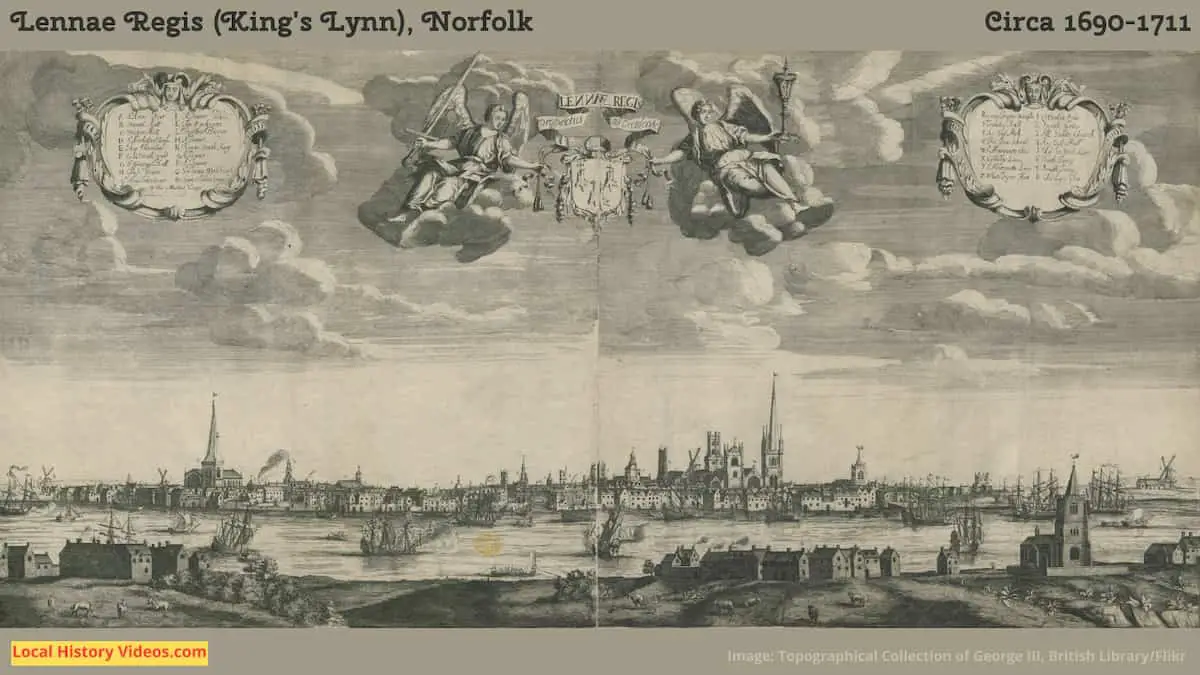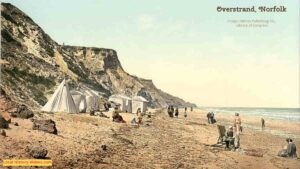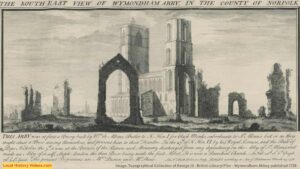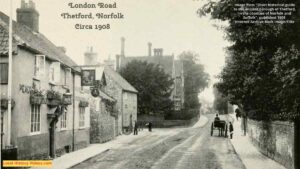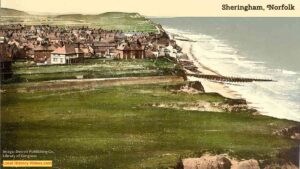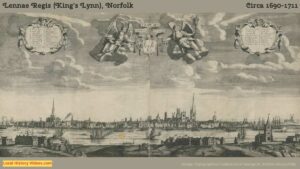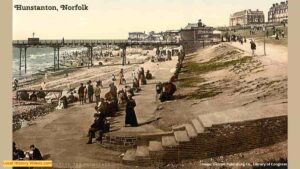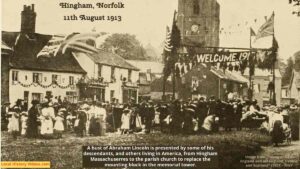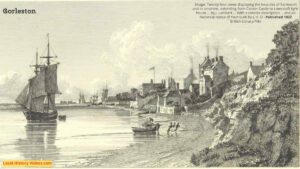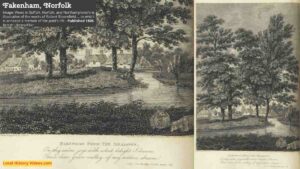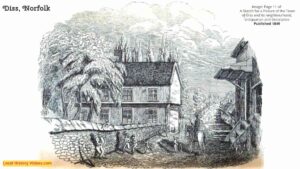Glimpse history through old images of King’s Lynn, Norfolk, England.
Lennae Regis
The 1085 Domesday Book mentions saltings at Lena, or Lynn, which may have been the beginnings of the West Norfolk town which was known as Len Episcopi, or Bishop’s Lynn, in the medieval age, when it was under the temporal and spiritual jurisdiction of the Bishop of Norwich.
But during the reign of King Henry VIII, when religious life and institutions were upended with reform and Dissolution, the town was renamed Lennae Regis, or King’s Lynn.
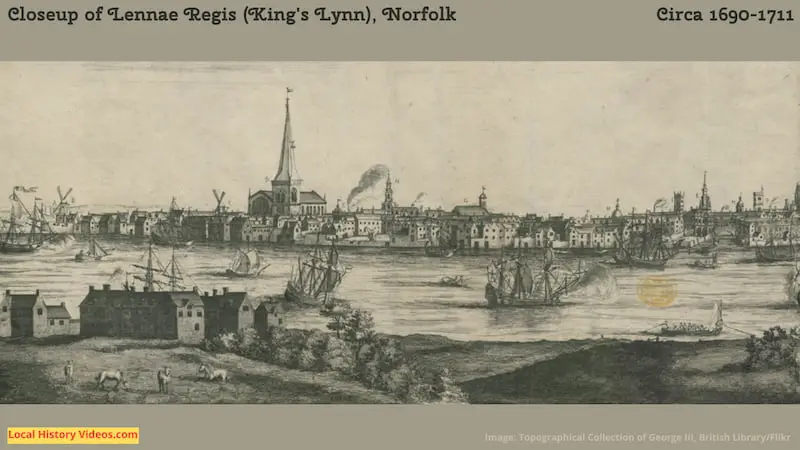
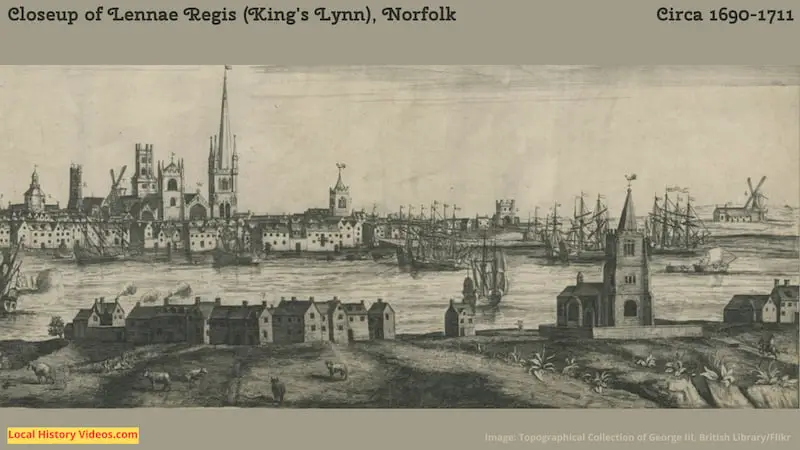
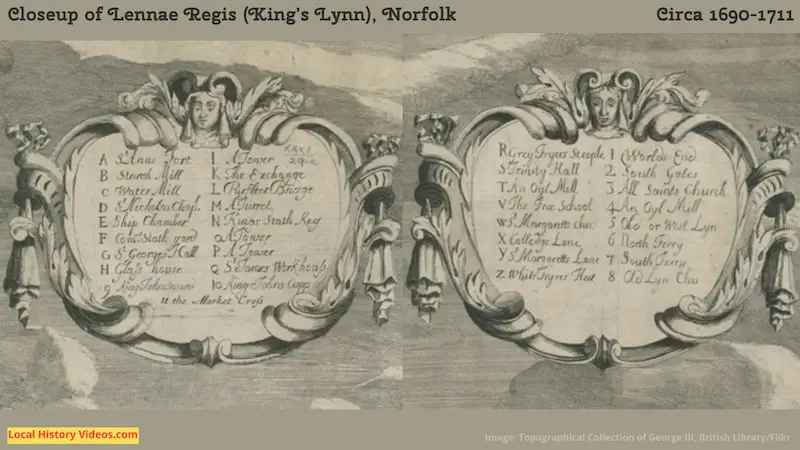
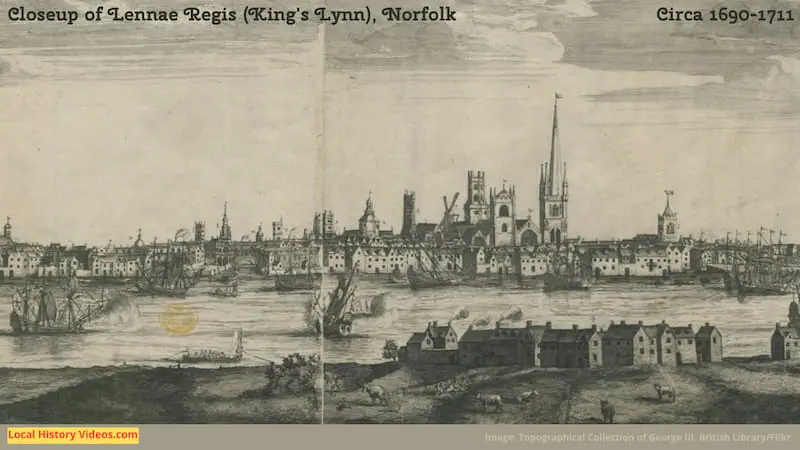
Gruesome Local Events
1189 – the local Jewish residents were murdered in widespread massacres;
1590 – Margaret Read was burned as a witch;
1616 – Mary Smith was hanged as a witch;
1708 – Michael Hammond, aged 7, and his sister Ann, aged 11, were publicly hanged near the South Gates…..for stealing a loaf of bread.
1930s King’s Lynn
Silent, black and white footage of a Civic procession and presentation of a painting show the key players of the local council in the 1930s, along with a couple of nice shots of the centre of town, and the crowds of people who turned out for this event.
King’s Lynn (1930-1939) – British Pathé on YouTube
A Bit of King’s Lynn History
Extract from “Post office directory of the Norfolk counties; viz.: – Cambridge, Norfolk, Suffolk [afterw.] Post office directory of Cambridge, Norfolk and Suffolk [afterw.] The Post office directory of Norfolk and Suffolk [afterw.] Kelly’s directory of Cambridgeshire, Norfolk and Suffolk“, by Kelly’s Directories, Ltd.
Published in 1875
Pages 332 – 334
LYNN, KING’S LYNN, OF LYNN REGIS, is the chief town in West Norfolk, and the great seaport of all the eastern lowlands: it lies on the east bank of the Great Ouse, near the junction of the Nar navigation, 2 miles from the Wash, 99 from London by railway and 981 by road, 414 north – east from Cambridge, 263 north – west – by – west from Dereham, 11 north from Downham Market, 26 north from Ely, 48 ) west by – north from Norwich, 14 north – west – by – west from Swaffham, and 153 north – east from Wisbech: it is a parliamentary and municipal borough, with separate jurisdiction, a seaport, market and union town, polling – place for the
Western division of the county, and head of a county court district, in the hundred of Freebridge Lynn, rural deanery of Lynn, and archdeaconry and diocese of Norwich.
This is the terminus of the Great Eastern, Great Northern, and Midland Companies, having direct railway communication with London, Hunstanton, Ely, Norwich, Grimsby, and Hull; and by way of Cambridge, Peterborough and Stamford, to all the principal towns in the north and west of the kingdom.
The town is very ancient, but was not of much importance prior to the Norman Accession. King John visited Lynn in 1205, and on the petition of John Grey, Bishop of Norwich, that monarch granted Lynn a charter to be a free borough. The borough has sent two members to Parliament since the 26th of Edward I., and has no fewer than nineteen charters, granted during the reigns of John, Henry III., Edward 1., Edward II., Edward III., Henry V., Henry VIII., Edward VI., Philip and Mary, James I., Charles II., and George II.
The first governing charter, which appointed and fixed the municipal corporation, was granted by Henry VIII., and the government consisted of a mayor, twelve aldermen, eighteen councillors, recorder, and town clerk.
Under the Municipal Corporation Act the borough is divided into three wards, and the corporation consists of a mayor, six aldermen, and eighteen councillors and has a high steward, recorder, town clerk, coroner, treasurer, sword – bearer, town crier, and sergeants – at – mace.
The mayor and ex – mayor, with other justices, are included in a separate commission of the peace, under which petty sessions are held on Mondays at the Guildhall, and a court
of quarter sessions. There is a borough court for the trial of civil actions, court of conscience, and court – leet, formerly held by the corporation as lords of the manor. The revenue of the corporation is about £4,000 a year, besides which there are large charitable endowments, under the management of Charity Commissioners.
The corporation possesses an elegant enamelled cup and cover of silver, double gilt, weighing 73 ounces, and holding about half a pint: this cup was presented by King John. The sword that is carried before the mayor is said to have been the gift of Henry VIII.; besides which four silver maces ( gilt ), are carried before the mayor on all public occasions.
Among the possessions of the corporation is the ferry over the river Ouse.
The freemen of Lynn, besides other privileges, enjoy an exemption from town dues, but they and their privileges are becoming extinct.
There is a local police force. The borough gaol having been abolished as such, a few years since, is now used as a lock – up, convicted prisoners being sent to Swaffham, Wymondham, or Norwich.
The port of Lynn, from its position in relation to the inland navigation connected with it on the one hand, and its free communication with the German Ocean on the other, is of considerable importance, especially in the corn and coal trades. The harbour is formed in the Great Ouse river, and is very deep it will hold upwards of 300 vessels: the tide rises 22 feet. The entrance to it was formerly rendered difficult by the tortuous course of the channel, and the variety of shifting sandbanks: this, however, has been remedied by the improvements made by the Norfolk Estuary Company. The upper streams are under the care of the Conservators of the Onse outfall, and have been much improved. The harbour of Lynn, and other local works, are under the government of the corporation and several bodies of commissioners.
The number of vessels belonging to this port is 100, of the aggregate tonnage of 9,200 employing 600 seamen, besides small craft, lighters, and 120 fishing – boats. The exports are principally corn, wool, sand, and coprolite to the English ports, and coal and manufactured goods for the foreign trade. The imports are coal, timber, wine, and oilcake. The wine trade here is as ancient as the time of Henry III.
The fisheries are in shrimps, cockles, smelts, cod and whelks; above 60 tous of shrimps alone are sent to London yearly.
There are malthouses and breweries, corn mills, iron and brass foundries, agricultural Implement manufactories, cork – cutting establishments, machine makers and mill wrights, seed – crushers, coach – makers, rope and sail makers, tobacco manufactories, ship – building yard, a tannery, and a flax factory.
The Dock, which was constructed by Mr. Lawrence, from designs of Mr. Brunlees, was begun in 1867 and finished in 1869: it is situated at the north end of the town, adjoining the harbour, and contains about 62 acres of water area. The form is an irregular quadrangle, the southern side 780 feet in length and the northern 500; the width from south to north, between the edges of the quays, about 440 feet. At the water – surface the width is 420 feet, and the average depth of the dock is 31 feet. The inclination of the slopes forming the sides is 14 horizontal to 1 perpendicular, the slopes being faced, or paved, as it were, with solid concrete blocks. Small craft are able to approach near the margin; but to accommodate vessels of large draught, substantial timber staiths or projecting quays have been constructed; each staith is 32 feet long, projecting somewhat beyond the base of the slope, and its floor or deck is furnished with rails leading on to a furntable upon one of the two lines of railway by which the dock is entirely encompassed. There is a continuous covered timber wharf, 250 feet long, on the south side, which is furnished with steam cranes, and at which the continental steamers load and discharge their cargoes. There is a powerful hydraulic lift at the end of the dock for the shipment of coal from the Nottinghamshire and Derbyshire coal – fields, and this branch of the export trade is already very extensive: in 1873 the quantity shipped was only a few hundred tons, but in 1874 it had increased to over 20,000 tons. With these appliances there is accommodation for the direct loading or delivery of several vessels of an average tonnage of 1,000 each. The total capacity of the dock is about 50,000 tons.
The work of excavation brought to light some interesting relies of antiquity, more or less remote: from the drift have been taken out many tons of bones of animals extinct in this country – such as the elephant, wild boar, tiger, elk, wolf, beaver, and others of far greater antiquity.
A fine collection of specimens is preserved, together with British, Roman, and Saxon pottery, and other objects brought to light after an interment of many centuries.
The dimensions of the lock are: -width, 50 feet; length between gates, 200 feet; depth, 30 feet. The platforms on which the lock gates work are 9 feet 6 inches below low water of average tides, and with the surrounding walls comprise an immense mass of substantial masonry. The stone used is the Bramley Fall, a very hard and durable millstone grit. A branch railway, three – quarters of a mile in length, owned by the Dock Company, connects the dock with the Great Eastern, Midiand, and Great Northern railway systems. The docks were formally opened by H.R.H. the Prince of Wales, on the 7th July, 1800, and named the Alexandra Docks.
The town on the land side is encompassed by a fosse, formerly defended by a strong embattled wall, flanked by nine bastions: fragments still remain of the wall, together with the south gate, a fine Gothic tower, with a lofty pointed archway for carriages and two smaller ones for foot passengers. Near the fosse, on the east side of the town, is an octagonal tower, called the Red Mount, no doubt formerly used for military as well as ecclesiastical purposes.
The town is about a mile and a quarter in length, and more than half a mile in breadth: its eastern suburb rises in gentle eminences, interspersed with villas and thriving plantations.
The streets and lanes are generally narrow, but clean and well paved, and there are many excellent shops and good hotels. Near the London road are public walks, planted with trees and shrubs; one of these extends from Guanock terrace, at the south end of the town, to the Red Mount, and from thence along the site of the town wall, of which the remains are fast disappearing, as far as the Railway Station. This pleasant promenade has a range of lofty lime and chestnut trees on each side, forming a shady avenue, with recessed seats at convenient distances, one of which is surrounded by a group of trees called the Seven Sisters.
The Marshland Iron Bridge, over the river Ouse, connecting Lynn with West Lynn, built by the Ouse Outfall Commissioners, at a cost of £20,000, opened the 30th July, 1873, is a wrought iron lattice girder bridge, 500 feet between the abutments, having a roadway 221 feet wide, and supported upon four piers.
The municipal borough consists of the parishes of St. Margaret’s and All Saints ‘, or South Lynn: the parliamentary borough includes part of Gaywood.
St. Margaret’s church, formerly that of a priory, is a fine structure of freestone, with two large towers at the west end, 86 feet high, one of which was formerly surmounted by a spire 258 feet high, which was blown down in 1741, and destroyed in its fall the nave and lantern, which rose from the four arches at the intersection of the transept and nave: the building consists of chancel, nave, aisles and transepts: the church, though curtailed from its original dimensions, is still a noble pile, 240 feet long and 132 feet broad, and is lighted by 70 windows: it is chiefly in the Early English and Perpendicular styles, but the nave and aisles were rebuilt in a debased style, though of excellent material and workmanship, in 1747, when the whole edifice was new roofed and thoroughly repaired and re – pewed: the chancel has a fine east window, and contains several carved stalls, some ancient memorials, and curious old brasses: the chapels adjoining the chancel are dedicated to The Trinity and St. Stephen: two chapels on the south side have been taken down: one of the towers contains a clock and a peal of 8 bells. This church has recently undergone very extensive alterations, no less a sum than £7,000 having been expended upon it, nearly the whole of which has been raised by public subscription. The work of restoration, so far as the nave and aisles were concerned, was under the direction of Sir Gilbert Scott, while that of the chancel was undertaken by the Ecclesiastical Commissioners, who placed it in the hands of their architect, Mr. Ewan Christian.
The living is a vicarage, annexed to the rectory of North Lynn, joint yearly value £549, in the gift of the Dean and Chapter of Norwich, and held by the Rev. John Durst, M.A., of Caius College, Cambridge.
St. Nicholas is a chapel of ease to St. Margaret: it is an ancient structure, in the Late Perpendicular style, 200 feet long and 78 feet wide, with a fine open – work roof: it has a very large and elegantly painted cast window: the font is of finely – wronght stone, standing on a pyramidal flight of steps; it was presented by Bishop Harsnett in 1627: the tower contains a peal of 8 bells: a beautiful spire, designed by Sir G. Gilbert Scott, R.A., was erected by public subscription in 1869.
All Saints ‘ church, Church lane, the parish church of SOUTH LYNN, is an ancient cruciformn structure, with a bell turret containing 1 bell: it had formerly a tower at the west end, but it fell down in 1763: it consists of chancel, nave, aisles, and transept: in 1860 this church was thoroughly repaired and re – seated. The register dates from the year 1558. The living is a vicarage, yearly value £180, in the gift of the Bishop of Norwich, and held by the Rev. William Leeper, M.A., of Trinity College, Dublin. The rectorial tithes are impropriate.
St. John the Evangelist is an ecclesiastical district or parish, formed in 1846 out of St. Margaret’s parish. The church in Blackfriars road is in the Early English style, and was opened on September 24th, 1846: it contains 1,008 sittings, 800 of which are free: the cost of the editice was about £5,000, which was raised partly by subscription and partly by a grant from the Society for Building and Enlarging Churches; the corporation gave the site. The register dates from the year 1846. The living is a vicarage, yearly value £150, with residence, in the gift of the Bishop of Norwich, and held by the Rev. John Fernie, M.A., of Emmanuel College, Cambridge.
The Borough Cemetery is on the Hardwick road: it covers about eight acres of land, and is neatly laid out.
The Grammar school was founded by Thomas Thoresby in the reign of Henry VIII., and is under the control of the town council: the school – room and master’s house have been rebuilt: the mastership is endowed: there are no free scholars; there are some small exhibitions. Eugene Aram, who was usher of Lynn Grammar school, under Mr. James Knox, was apprehended here in 1759 for the murder of Daniel Clarke, committed at Knaresborough, in Yorkshire, in 1744, and for which he was executed at York.
There are several National schools for boys, girls, and infants, and a British school for boys and girls.
The Roman Catholic church, London road, is a handsome structure, in the Decorated style, dedicated to St. Mary: it was erected in 1844, from a design of A. Welby Pugin, esq., at a cost of £2,500: the east window is filled with stained glass in 1802 a north aisle was added, and a residence for the priest built. The Rev. Stodart Macdonald is the priest.
The Independent chapel, New Conduit street, was erected in 1838, at a cost of about £3,000, and contains about 900 sittings.
The Wesleyan chapel, Tower street, is a commodious structure, erected in 1812, at a cost of £4,500. The Wesleyans have also two smaller chapels in the town, one on the London road, and the other in North street.
The Baptist chapel, Blackfriars road, was erected in 1841, at a cost of £2,000. During 1874 the interior of the building has undergone extensive alterations, and has been re – seated and beautified at an outlay of £700.
The Methodist New Connexion chapel, Railway road, is a brick building, erected in 1852-3, at a cost of about £2,000: it will accommodate 800 persons.
There are also places of worship for the Primitive. Methodists, Unitarians, and the Society of Friends.
The Primitive Methodists have erected a chapel in the London road, at a cost of about £2,000: it is a brick building, in the Italian style, with 800 sittings, and was opened in 1857.
A church called the Free Christian church, was erected in 1875: it is built of white bricks, with red brick bandings and Bath stone dressings, in the Middle – Pointed style: it is paved with encaustic tiles, and the roof is open – timbered: the church is lighted by eight windows, filled with cathedral glass, with colored borders, some with medieval patterns, and the heads filled in with rich colored glass, some in geometrical patterns and others with painted scriptural subjects, those at the west end being ” Christ and the Woman of Samaria, ” and ” The Good Samaritan; ” while the centre window on the north side has ” Christ Blessing Little Children: ” the roof here is partly open, the tie – beams being below the ceiling, with pierced spandrils and pendants, supported on stone corbels: the ceiling is divided by moulded ribs running longitudinally, and all stained: the floor is boarded, and at the west end is a raised dais; at the back of this is a screen, behind which the organ has been placed: the choir benches are placed on each side of the dais, and have pitch pine ends, cut and pierced: the seats for the congregation are in three blocks, leaving an aisle or passage on each side; they are open benches, stained and varnished, with pitch pine ends, similar in design to those for the choir, and will seat comfortably 160 persons. The total cost of the building exceeded £1,400, which was raised by voluntary subscription. The stained glass, gas fittings, and organ case are the special gifts of James Hopgood, esq., of London. Messrs. Adams and Son, of Lynn and Wisbech, were the architects, and Mr. John Leach the builder.
The Union Baptist chapel, Market street, was built in 1859, at a cost of £3,000, by persons who seceded from various Baptist and Independent congregations: it is in an Early English style, eruciform, with a small tower and square spire, and contains 500 sittings.
The County Court, on the east side of the London road, was erected in 1861: it is a plain brick building, in the Italian style.
The following parishes comprise the district: Anmer, Ashwicken, Babingley, Bawsey, Bilney West, Castle Rising, Clenchwarton, Cougham, Dersingham, Flitcham, Gaywood, Gaywood Highgate, Gayton, Gayton Thorpe, Grimston, Hunstanton, Hardwicke, Holme – next the – Sea, Harpley, Heacham, Hillington, Ingoldisthorpe, Lynn West, Lynn North, Leziate, Massingham Great, Massingham Little, Middleton, Mintlyn, Newton West, Pentney, Roydon, Runcton North, Ringstead Great, Saddlebow, Sandringham, Sedgeford, Setch, Shernburne, Snettisham, Terrington St. Clement, Terrington St. John, Terrington Cross Keys, Tilney All Saints, Tilney St. Laurence, Tilney cum – Islington, Walton East, Winch East, Winch West, Wollerton, Wootton North, Wootton South, Wiggenhall St. Mary Magdalen, Wiggenhall St. Mary the Virgin, and Wiggenhall St. Germans.
The Corn Exchange. Tuesday Market place, is a large brick building, with stone frontage: it was erected in 1854.
The Custom House, Purfleet quay, is a building of free stone, in the Italian style, with a curious pyramidal roof, from which rises a small open turret, terminating in a pinnacle at the height of 90 feet: a statue of Charles 11. Is placed over the entrance: the building was erected in 1683.
The Guildhall, formerly the hall of the Trinity Guild, is situated in Saturday Market place: it has a fine Gothic window and Renaissance porch of flint and stone. The Assembly Rooms form a part of the building, and open out by means of folding – doors, so as to form an elegant apartment, 87 feet long by 22 feet broad, and 22 feet in height: adjoining these are the council and magistrates ‘ rooms.
Many excellent paintings adorn the walls of the various rooms. Here are preserved the Red Register of Lynn, said to be the oldest paper book in existence, and many other ancient muniments of the Corporation.
The Athenaeum, erected in 1854, is a commodious brick building, situated in Baxter’s plain, in the centre of the town, and is the home of several local institutions for the promotion of literature, science, and art. 1st.
The Subscription Library, numbering above 10,000 volumes, and 100 annual subscribers of one guinea each; 2nd. The Stanley Library and Reading Room, founded by a munificent grant by the present Earl of Derby, formerly member for the town, principally for the working classes, contains 6,000 volumes, and has 400 subscribers, the lowest scale off subscription being one shilling per quarter; 3rd. The Museum, a spacious hall and gallery, particularly rich in ornithology, and to which J. H. Gurney, esq., was a munificent contributor: the museum is supported by subscription, but is freely open to the publie; 4th. The Conversazione, a society which works by lectures, papers, and discussions; 5th. The Philharmonic, a very flourishing musical society; and 6th. The church of England Young Men’s Society.
Besides the apartments specially appropriated to these several societies, the Athenicum comprises numerous rooms and offices, which are let for general purposes; and a very fine hall, 84 feet long by 42 feet broad, which is used for concerts, lectures, and exhibitions in connection with the associated societies, and is also let for the general purposes of a public room. The Atheneum was built by public subscription and loan, but fell into the hands of mortgagees; it is now private property.
The Union House, Exton’s road, is a large brick building, erected in 1856, at the cost of above £12,000: it will accommodate 410 persons; the present number of inmates is 150; the chapel is over the dining room; a fever ward is situated a short distance from the main body of the building.
The union comprises four parishes, viz., All Saints (South Lynn), St. Edmund (North Lynn), St. Margaret (King’s Lynn), and St. Peter (West Lynn), covering an area of 5,334 acres, and embracing a population in 1871 of 17,132. The guardians meet at the Union House on Fridays.
The Lynn Public Baths are situated on Common Staith quay: the building is of brick, and comprises hot and cold, salt and fresh water baths, also shower and swimming baths; they were opened on the 4th July, 1856.
The Pilot Office, also on Common Staith quay, is a building of red brick, surmounted by an octagonal tower 50 feet high: it was erected in 1863.
The Water Works, which are very ancient, have been modernised and improved of late years, and are the property of the corporation.
The Gas Works, Southgate, were established in 1825, by Mr. Malam. They have been recently sold to, and are now worked by, the King’s Lynn Gas Co.: since they were first. erected they have been considerably enlarged.
The Savings Bank, in St. James street, is a brick building, in the Tudor style, and was erected in 1860, at a cost of about £2,000.
The Theatre is a brick building, in St. James street, and, though not large, is held to be one of the neatest and best arranged in the provinces; the corporation are part proprietors with other shareholders.
Lynn is a great market for cattle, corn, and other agricultural produce, which are brought here for shipment.
The markets are held on Tuesday and Saturday; the former are for corn and cattle, and are the principal markets. There are two market places, called the Tuesday and Saturday Market places; in the latter is a market house for butchers, in the former the Corn Exchange, meat, poultry and fish market. In the centre of the Tuesday Market is a handsome pillar, combining gas lamp and public fountain, the gift of Mr. Malam, and erected at a cost of about 300.
The cattle market is in Paradise field; it is held on Tuesday, and is very largely supplied with sheep and cattle. Fairs are held as follows – one, called the Mart, commences on St. Valentine’s Day, and lasts for a fortnight; another, called the Cheese fair, is held on the 17th of October: both were formerly of great commercial importance, but now are merely pleasure fairs. There are cattle fairs held on the second Monday in the months of April and November.
The West Norfolk and Lynn Hospital, near the London road, is a spacious and handsome building of white brick; it was established December 16th, 1834, and erected at a cost of more than £3,000; in 1847 two wings were added, called the Harwood and Hankinson wards; the building will now accommodate 52 inmates; it is supported by voluntary contributions.
The following are the almshouses in the town: Framingham’s Hospital, situated in the London road, is a handsome brick building with stone dressings, having convenient apartments for twelve inmates; a chapel is attached to it; the hospital has a lawn in front, and a small garden
behind for each inmate: it was founded in 1676, and derives its name from Alderman Framingham; it has a revenue of £500.
St. James ‘ Hospital, St. James ‘ road, was founded in the fourteenth century, but rebuilt in 1722; it has a chapel and twelve houses, and the revenue is about £150.
The Wesleyan, or Smith’s, Almshouses, St. James ‘ road, are for eight poor women above sixty years of age; they were founded by Benjamin Smith, esq., in 1822, who also endowed them; the endowment is about £30 per annum.
Elsden’s Almhouses, in South Lynn, founded in 1842, have an income of £122; they are for eight persons.
Valinger’s Almshouses, South Lynn plain, are for four poor women of South Lynn parish; they were founded in 1811 by Thomas Valinger; the endowment is about £34 per annum. The other charities of the town are considerable.
St. Margaret’s Library was founded in 1617, and contains about 1,700 volumes.
Lynn passed into the hands of the ecclesiasties before the Norman Accession, at which period it was already a port, with considerable customs and many salt works. In the reign of William Rufus, Bishop Herbert founded the church and priory of St. Margaret; and the prior of Norwich obtained the grant of a fair to be held at Lynn on the feast of St. Margaret, with various other privileges, in the time of Henry I. In the reign of Henry VIII. much of the ecclesiastical property passed to the crown, and the name of the borough was changed from Lynn Episcopi to Lynn Regis.
During the Civil Wars, in the reign of Charles I., the Mayor and Burgesses of Lynn declared for the Royal cause, and placed the town in a position of defence against the attack of 18,000 Parliamentary soldiers, under the command of the Earl of Manchester. The town was closely besieged from August 28th to September 26th, when the garrison, consisting of 5,000 men, was obliged to surrender. During the siege, on Sunday, September 3rd, 1643, when the
minister and congregation were assembled for Divine Worship, a sixteen pound shot was fired from West Lynn into St. Margaret’s church, where it did no further harm than to shatter a pillar into pieces, and disperse the people. After the siege the town was garrisoned for the Parliament, and so remained during the Civil War.
Near St. James ‘ street is a fine hexagonal tower, the remains of the Grey Friary, founded in 1204, and now used as a landmark.
The following eminent literary men were natives of Lynn, viz.:-Capgrave, a Franciscan friar, author of the ” Chronicles of England, ” and other works; Nicholas, or Friar Nicholas, a musician and astronomer, who died in 1960; William Sautre, or Santer, a Wickliffite priest, who was burnt at Smithfield in 1401; William Gale, an eminent member of the Augustine order, who died in 1507; Sir Benjamin Keene, an ambassador, who died in 1757; and W. Whittingham, a bookseller, editor of one of the editions of the County History, who died in 1818.
WEST, OR OLD LYNN, is a suburb and parish on the west bank of the Ouse, with which there is a communication by a ferry and bridge. GAYWOOD is also a suburban parish, and includes Highgate and Albion Place. The Directory of these suburbs will be found under separate headings.
The area of the parish is 2,808 acres, inclusive of 55 acres of water; rateable value, £47,475; and the population in 1871 was, All Saints, 4,757, and St. Margaret’s, 11,805; total, 16,562; the population of the municipal borough in 1871 was 16,562: and of the parliamentary borough, 17,206; which includes part of Gaywood.
More Pictures of Old King’s Lynn
Old King’s Lynn in Norfolk, England, enjoyed through historic photos, vintage pictures & archive film. Browse history in these fascinating old images of a bygone era on my Pinterest board at:
https://www.pinterest.co.uk/LocalHistoryVideos/kings-lynn-old-photos-pictures
More about Norfolk
- Old Images of Norfolk, EnglandGlimpse history through old images of Norfolk, England.
- Old Images of Wymondham, NorfolkGlimpse history through old images of Wymondham, Norfolk, England.
- Old Images of Thetford, NorfolkGlimpse history through old images of Thetford, Norfolk, England.
- Old Images of Sheringham, NorfolkGlimpse history through old images of Sheringham, Norfolk, England.
- Old Images of King’s Lynn, NorfolkGlimpse history through old images of King’s Lynn, Norfolk, England. Lennae Regis The 1085 Domesday Book mentions saltings at Lena, or Lynn, which may have been the beginnings of the West Norfolk town which was known as Len Episcopi, or Bishop’s Lynn, in the medieval age, when it was under the temporal and spiritual jurisdiction… Read more: Old Images of King’s Lynn, Norfolk
- Old Images of Hunstanton, NorfolkGlimpse history through old images of Hunstanton, Norfolk, England.
- Old Images of Hingham, NorfolkGlimpse history through old images of Hingham, Norfolk, England.
- Old Images of Gorleston-on-Sea, NorfolkGlimpse history through old images of Gorleston-on-Sea, Norfolk, England, usually known as Gorleston.
- Old Images of Fakenham, NorfolkGlimpse history through old images of Fakenham, Norfolk, England.
- Old Images of Diss, NorfolkGlimpse history through old images of Diss, Norfolk, England.

